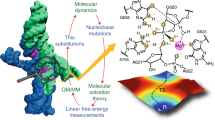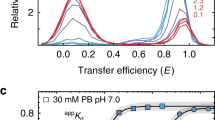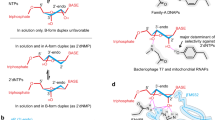Abstract
Ribozymes enhance chemical reaction rates using many of the same catalytic strategies as protein enzymes. In the hepatitis delta virus (HDV) ribozyme, site-specific self-cleavage of the viral RNA phosphodiester backbone1,2,3 requires both divalent cations and a cytidine nucleotide4,5,6. General acid–base catalysis7,8,9,10,11,12, substrate destabilization1,13 and global and local conformational changes14,15 have all been proposed to contribute to the ribozyme catalytic mechanism. Here we report ten crystal structures of the HDV ribozyme in its pre-cleaved state, showing that cytidine is positioned to activate the 2′-OH nucleophile in the precursor structure. This observation supports its proposed role as a general base in the reaction mechanism. Comparison of crystal structures of the ribozyme in the pre- and post-cleavage states reveals a significant conformational change in the RNA after cleavage and that a catalytically critical divalent metal ion from the active site is ejected. The HDV ribozyme has remarkable chemical similarity to protein ribonucleases and to zymogens for which conformational dynamics are integral to biological activity. This finding implies that RNA structural rearrangements control the reactivity of ribozymes and ribonucleoprotein enzymes.
This is a preview of subscription content, access via your institution
Access options
Subscribe to this journal
Receive 51 print issues and online access
$199.00 per year
only $3.90 per issue
Buy this article
- Purchase on Springer Link
- Instant access to full article PDF
Prices may be subject to local taxes which are calculated during checkout



Similar content being viewed by others
References
Shih, I. H. & Been, M. D. Catalytic strategies of the hepatitis delta virus ribozymes. Annu. Rev. Biochem. 71, 887–917 (2002)
Rosenstein, S. P. & Been, M. D. Self-cleavage of hepatitis delta virus genomic strand RNA is enhanced under partially denaturing conditions. Biochemistry 29, 8011–8016 (1990)
Reid, C. E. & Lazinski, D. W. A host-specific function is required for ligation of a wide variety of ribozyme-processed RNAs. Proc. Natl Acad. Sci. USA 97, 424–429 (2000)
Suh, Y. A., Kumar, P. K., Taira, K. & Nishikawa, S. Self-cleavage activity of the genomic HDV ribozyme in the presence of various divalent metal ions. Nucleic Acids Res. 21, 3277–3280 (1993)
Nakano, S., Proctor, D. J. & Bevilacqua, P. C. Mechanistic characterization of the HDV genomic ribozyme: assessing the catalytic and structural contributions of divalent metal ions within a multichannel reaction mechanism. Biochemistry 40, 12022–12038 (2001)
Tanner, N. K. et al. A three-dimensional model of hepatitis delta virus ribozyme based on biochemical and mutational analyses. Curr. Biol. 4, 488–498 (1994)
Ferre-D'Amare, A. R., Zhou, K. & Doudna, J. A. Crystal structure of a hepatitis delta virus ribozyme. Nature 395, 567–574 (1998)
Ferre-D'Amare, A. R. & Doudna, J. A. Crystallization and structure determination of a hepatitis delta virus ribozyme: use of the RNA-binding protein U1A as a crystallization module. J. Mol. Biol. 295, 541–556 (2000)
Oyelere, A. K., Kardon, J. R. & Strobel, S. A. pK(a) perturbation in genomic Hepatitis Delta Virus ribozyme catalysis evidenced by nucleotide analogue interference mapping. Biochemistry 41, 3667–3675 (2002)
Perrotta, A. T., Shih, I. & Been, M. D. Imidazole rescue of a cytosine mutation in a self-cleaving ribozyme. Science 286, 123–126 (1999)
Shih, I. H. & Been, M. D. Involvement of a cytosine side chain in proton transfer in the rate-determining step of ribozyme self-cleavage. Proc. Natl Acad. Sci. USA 98, 1489–1494 (2001)
Nakano, S., Chadalavada, D. M. & Bevilacqua, P. C. General acid-base catalysis in the mechanism of a hepatitis delta virus ribozyme. Science 287, 1493–1497 (2000)
Shih, I. & Been, M. D. Energetic contribution of non-essential 5′ sequence to catalysis in a hepatitis delta virus ribozyme. EMBO J. 20, 4884–4891 (2001)
Pereira, M. J., Harris, D. A., Rueda, D. & Walter, N. G. Reaction pathway of the trans-acting hepatitis delta virus ribozyme: a conformational change accompanies catalysis. Biochemistry 41, 730–740 (2002)
Harris, D. A., Rueda, D. & Walter, N. G. Local conformational changes in the catalytic core of the trans-acting hepatitis delta virus ribozyme accompany catalysis. Biochemistry 41, 12051–12061 (2002)
Perrotta, A. T. & Been, M. D. A pseudoknot-like structure required for efficient self-cleavage of hepatitis delta virus RNA. Nature 350, 434–436 (1991)
Jeong, S., Sefcikova, J., Tinsley, R. A., Rueda, D. & Walter, N. G. Trans-acting hepatitis delta virus ribozyme: catalytic core and global structure are dependent on the 5′ substrate sequence. Biochemistry 42, 7727–7740 (2003)
Pyle, A. M. Metal ions in the structure and function of RNA. J. Biol. Inorg. Chem. 7, 679–690 (2002)
Oyelere, A. K. & Strobel, S. A. Site specific incorporation of 6-azauridine into the genomic HDV ribozyme active site. Nucleosides Nucleotides Nucleic Acids 20, 1851–1858 (2001)
Chai, J. et al. Crystal structure of a procaspase-7 zymogen: mechanisms of activation and substrate binding. Cell 107, 399–407 (2001)
Rupert, P. B. & Ferre-D'Amare, A. R. Crystal structure of a hairpin ribozyme-inhibitor complex with implications for catalysis. Nature 410, 780–786 (2001)
Rupert, P. B., Massey, A. P., Sigurdsson, S. T. & Ferre-D'Amare, A. R. Transition state stabilization by a catalytic RNA. Science 298, 1421–1424 (2002)
Murray, J. B., Dunham, C. M. & Scott, W. G. A pH-dependent conformational change, rather than the chemical step, appears to be rate-limiting in the hammerhead ribozyme cleavage reaction. J. Mol. Biol. 315, 121–130 (2002)
Dunham, C. M., Murray, J. B. & Scott, W. G. A helical twist-induced conformational switch activates cleavage in the hammerhead ribozyme. J. Mol. Biol. 332, 327–336 (2003)
Luptak, A., Ferre-D'Amare, A. R., Zhou, K., Zilm, K. W. & Doudna, J. A. Direct pK(a) measurement of the active-site cytosine in a genomic hepatitis delta virus ribozyme. J. Am. Chem. Soc. 123, 8447–8452 (2001)
Moore, M. J. & Query, C. C. Joining of RNAs by splinted ligation. Methods Enzymol. 317, 109–123 (2000)
Otwinowski, Z. & Minor, W. Processing of x-ray diffraction data collected in oscillation mode. Methods Enzymol. 276, 307–326 (1997)
Terwilliger, T. C. & Berendzen, J. Automated MAD and MIR structure solution. Acta Crystallogr. D Biol. Crystallogr. 55, 849–861 (1999)
Brunger, A. T. et al. Crystallography and NMR System: A new software suite for macromolecular structure determination. Acta Cryst. D. 54, 905–921 (1998)
Collaborative Computational Project, The CCP4 Suite: Programs for protein crystallography. Acta Crystallogr. D. 50, 760–763 (1994)
Acknowledgements
Diffraction data for this study were measured with the guidance of C. Ralston, J. Holton and co-workers. We thank M. Been, K. Karbstein, J. Piccirilli, R. Spanggord and N. Walter for comments on the manuscript and for sharing unpublished data. This work was supported in part by the NIH.
Author information
Authors and Affiliations
Corresponding author
Ethics declarations
Competing interests
The authors declare that they have no competing financial interests.
Supplementary information
Supplementary Table S1
Crystallography statistics for ten structures of the wild type and C75U mutant precursor forms of the hepatitis delta virus (HDV) ribozyme. (DOC 61 kb)
Supplementary Figure S1
Identification of a metal ion in the wild type precursor ribozyme active site. (PPT 428 kb)
Supplementary Figure S2
Competitive inhibition of C75U mutant ribozyme reactivity by cobalt hexammine. (PPT 28 kb)
Rights and permissions
About this article
Cite this article
Ke, A., Zhou, K., Ding, F. et al. A conformational switch controls hepatitis delta virus ribozyme catalysis. Nature 429, 201–205 (2004). https://doi.org/10.1038/nature02522
Received:
Accepted:
Issue Date:
DOI: https://doi.org/10.1038/nature02522
This article is cited by
-
Thermodynamics of unfolding mechanisms of mouse mammary tumor virus pseudoknot from a coarse-grained loop-entropy model
Journal of Biological Physics (2022)
-
An algebraic language for RNA pseudoknots comparison
BMC Bioinformatics (2019)
-
The roles of structural dynamics in the cellular functions of RNAs
Nature Reviews Molecular Cell Biology (2019)
-
Construction and characterization of an improved DNA-launched infectious clone of duck hepatitis a virus type 1
Virology Journal (2017)
-
Crystal structure of an RNA-cleaving DNAzyme
Nature Communications (2017)
Comments
By submitting a comment you agree to abide by our Terms and Community Guidelines. If you find something abusive or that does not comply with our terms or guidelines please flag it as inappropriate.



